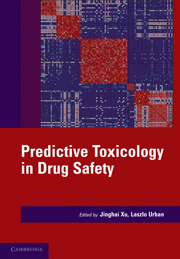Book contents
- Frontmatter
- Contents
- Contributors
- Prologue – Predictive toxicology: a new chapter in drug safety evaluation
- PREDICTIVE TOXICOLOGY IN DRUG SAFETY
- I SPECIFIC AREAS OF PREDICTIVE TOXICOLOGY
- 1 The human predictive value of combined animal toxicity testing: current state and emerging approaches
- 2 Screening approaches for genetic toxicity
- 3 Cardiac safety
- 4 Predicting drug-induced liver injury: safer patients or safer drugs?
- 5 In vitro evaluation of metabolic drug–drug interactions
- 6 Reliability of reactive metabolite and covalent binding assessments in prediction of idiosyncratic drug toxicity
- 7 Immunotoxicity: technologies for predicting immune stimulation, a focus on nucleic acids and haptens
- 8 Predictive models for neurotoxicity assessment
- 9 De-risking developmental toxicity-mediated drug attrition in the pharmaceutical industry
- II INTEGRATED APPROACHES OF PREDICTIVE TOXICOLOGY
- Epilogue
- Index
- Plate section
- References
8 - Predictive models for neurotoxicity assessment
from I - SPECIFIC AREAS OF PREDICTIVE TOXICOLOGY
Published online by Cambridge University Press: 06 December 2010
- Frontmatter
- Contents
- Contributors
- Prologue – Predictive toxicology: a new chapter in drug safety evaluation
- PREDICTIVE TOXICOLOGY IN DRUG SAFETY
- I SPECIFIC AREAS OF PREDICTIVE TOXICOLOGY
- 1 The human predictive value of combined animal toxicity testing: current state and emerging approaches
- 2 Screening approaches for genetic toxicity
- 3 Cardiac safety
- 4 Predicting drug-induced liver injury: safer patients or safer drugs?
- 5 In vitro evaluation of metabolic drug–drug interactions
- 6 Reliability of reactive metabolite and covalent binding assessments in prediction of idiosyncratic drug toxicity
- 7 Immunotoxicity: technologies for predicting immune stimulation, a focus on nucleic acids and haptens
- 8 Predictive models for neurotoxicity assessment
- 9 De-risking developmental toxicity-mediated drug attrition in the pharmaceutical industry
- II INTEGRATED APPROACHES OF PREDICTIVE TOXICOLOGY
- Epilogue
- Index
- Plate section
- References
Summary
INTRODUCTION
The human nervous system is one of the most complex organ systems in terms of both structure and function. It contains billions of neurons, each forming thousands of synapses leading to a very large number of connections. It also contains perhaps ten times more glial cells (astrocytes, oligodendrocytes, microglia) than neurons, which play important roles in the overall development and functioning of the nervous system. Anatomically, the nervous system is composed of a central (CNS) and a peripheral (PNS) component, whose basic functions are to detect and relay sensory information inside and outside the body, to direct motor functions, and to integrate thought processes, learning, and memory. Such functions and their complexity, together with some intrinsic characteristics (e.g., mature neurons do not divide, they are highly dependent upon oxygen and glucose) make the nervous system particularly vulnerable to toxic insults.
Neurotoxicity can be defined as any adverse effect on the chemistry, structure, or function of the nervous system, during development or at maturity, induced by chemical or physical influences. A first issue is what constitutes an adverse effect. A proposed definition of an adverse effect is “any treatment related change which interferes with normal function and compromises adaptation to the environment.” Thus, most morphological changes such as neuronopathy (a loss of neurons), axonopathy (a degeneration of the neuronal axon), or myelinopathy (a loss of the glial cells surrounding the axon), or other gliopathies, would be considered adverse, even if structural and/or functional changes were mild or transitory.
- Type
- Chapter
- Information
- Predictive Toxicology in Drug Safety , pp. 135 - 152Publisher: Cambridge University PressPrint publication year: 2010
References
- 1
- Cited by



